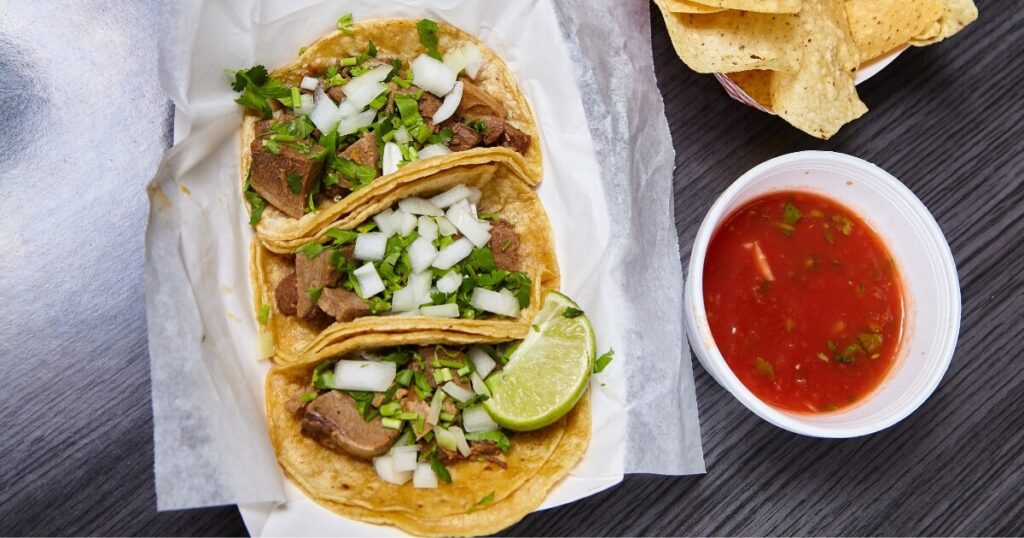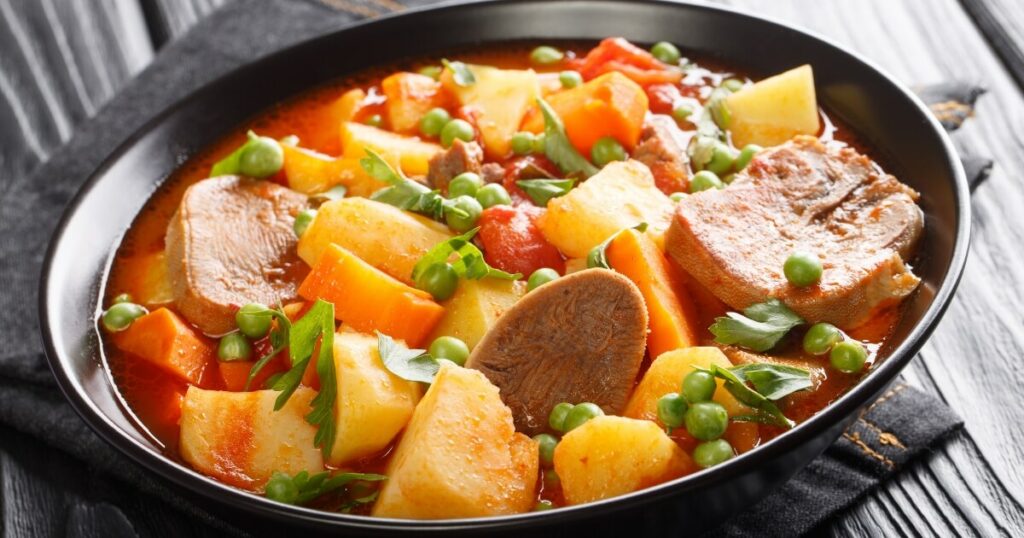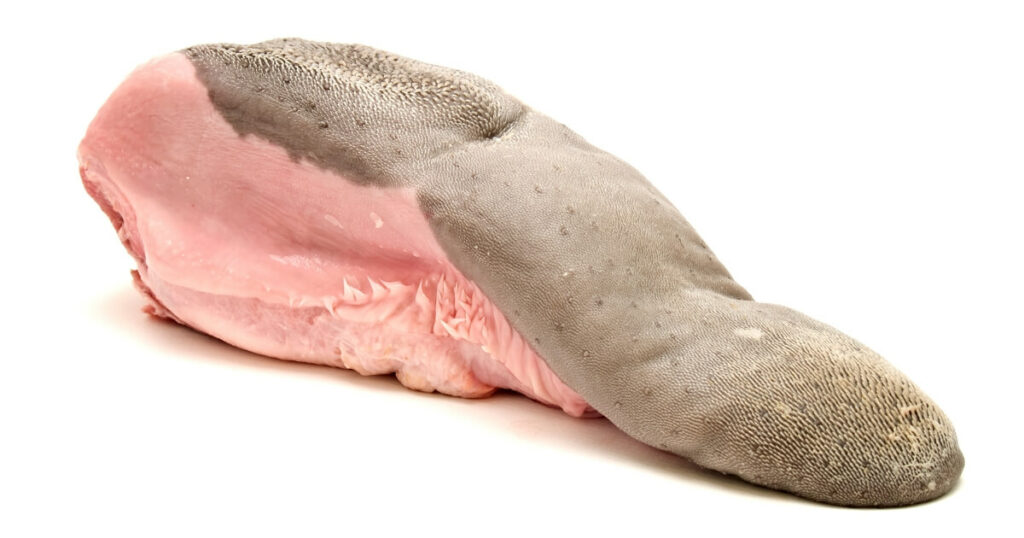Beef Tongue has a rich history in cuisines from all corners of the globe, from the sizzling street food of Mexico to the hearty stews of Eastern Europe.
But the question that’s probably on your mind right now is, “What does beef tongue taste like?” Well, my friend, you’re in for a treat.
We’re about to explore this intriguing ingredient’s taste, texture, and cooking methods.
So, buckle up and get ready for a flavor journey like no other. By the end of this, you might just find yourself adding beef tongue to your next shopping list!
How Does Beef Tongue Taste?
The taste of beef tongue is mild and beefy, with a soft texture that melts in your mouth. It has a hint of tanginess and a subtle spice kick that complements its mild flavor.

You’ll notice its soft texture when you first bite into a well-cooked piece of beef tongue. It’s not chewy like some cuts of meat can be, but rather it has a melt-in-your-mouth quality.
The taste is mild, similar to other cuts of beef, but with a depth of flavor that I really love.
You might also detect a hint of tanginess, a subtle spice kick that pairs well with the overall mild flavor of the beef tongue. This is particularly noticeable if the tongue has been cooked in a rich sauce or seasoned with spices.
As for the smell, it’s not unlike that of other cuts of beef when cooked. It has a warm, inviting aroma that is sure to make your mouth water.

The taste of beef tongue can vary depending on how it’s prepared and cooked.
For instance, if it’s slow-cooked in a stew, it might take on the flavors of the other ingredients, enhancing its own natural beefy flavor. On the other hand, if it’s grilled or pan-fried, it might have a more robust, meaty flavor with a slight char.
So, while the taste of beef tongue is generally mild and beefy, there’s a lot of room for variation depending on how you choose to cook it.
What Does Beef Tongue Compare With?
- Beef Cuts: The taste of beef tongue compares to other cuts of beef, such as flank steak or ribeye. It has a similar beefy flavor, although it’s generally milder.
- Liver: Some people find that beef tongue has a slight liver-like taste, especially when it’s not cooked properly. However, this can be avoided with the right preparation and cooking methods.
- Veal: Due to its mild flavor and soft texture, beef tongue can also be compared to veal. It’s not as rich, but it has a similar melt-in-your-mouth quality.
- Slow-Cooked Meats: Slow-cooked meats like pulled pork or braised beef cheeks might come close in terms of texture. These meats are tender and soft, much like a well-cooked beef tongue.
Does Beef Tongue Taste Good?
Like many things in life, it depends on personal preference.
The idea of eating tongue might put some folks off, and that’s perfectly okay.
Others might not be fans of its soft texture, preferring the firmness of more traditional cuts of meat. And while its mild flavor is a plus for some, others might find it a bit too subtle for their liking.
In the end, whether beef tongue tastes good or not really depends on your individual taste buds.
But if you’re adventurous when it comes to food and open to trying new things, beef tongue might just surprise you.
How To Make Beef Tongue Taste Good
- Slow Cook It: Beef tongue benefits greatly from slow, low-temperature cooking methods. This helps to break down the tough muscle fibers and results in a soft, tender texture. Try slow-cooking it with your favorite herbs and spices in a crockpot or Dutch oven.
- Use a Marinade: A flavorful marinade can help to enhance the mild flavor of beef tongue. You could use a mixture of soy sauce, garlic, ginger, and honey, or perhaps a spicy chipotle marinade for a bit of a kick.
- Braise It: Braising is another great way to cook beef tongue. This involves searing it first to lock in the flavors, then cooking it slowly in a small amount of liquid. This method can result in a tender, flavorful piece of meat.
- Slice It Thinly: Beef tongue can be quite thick, so slicing it thinly can make it easier to eat and allow the flavors to permeate more effectively.
- Serve with a Sauce: A tangy sauce or a rich gravy can complement the mild flavor of beef tongue. Consider serving it with homemade barbecue sauce, spicy salsa, or savory mushroom gravy.
How To Eat Beef Tongue
Tacos de Lengua

One of the most popular ways to enjoy beef tongue is in tacos, a dish known as “tacos de lengua.” This Mexican street food staple involves slow-cooking the tongue until it’s tender, then chopping it up and serving it on a warm corn tortilla.
The beefy, mild flavor of the tongue pairs beautifully with fresh cilantro, diced onions, and a squeeze of lime.
Beef Tongue Stew

Another delicious way to eat beef tongue is in a hearty stew. The tongue is slow-cooked with vegetables, herbs, and spices until it’s falling-apart tender.
The result is a rich, flavorful stew where the tongue becomes the star of the show. The tongue’s mild flavor absorbs the stew’s flavors, making each bite a taste sensation.
Grilled Beef Tongue

Grilled beef tongue is a must-try for those who enjoy a bit of char on their meat. The tongue is marinated, then grilled over high heat until it’s nicely browned and slightly crispy on the outside.
This method gives the tongue a robust, meaty flavor that’s sure to satisfy any carnivore.
Beef Tongue Sandwiches
Last but not least, beef tongue makes for a fantastic sandwich filling. Thinly sliced, tender beef tongue can be piled high on a soft roll, topped with your favorite condiments, and enjoyed as a satisfying lunch.
The soft texture of the tongue contrasts nicely with the crunch of the bread, making for a tasty and texturally interesting sandwich.
What Does Beef Tongue Look Like?
In its raw form, a beef tongue is quite large and has a distinctive shape. It’s long and narrow, with a rounded tip at one end.

The color can be a deep, rich red or pink, similar to other cuts of beef. The surface of the tongue is covered in a layer of skin that has a slightly bumpy texture due to the presence of taste buds.
Once cooked, the beef tongue undergoes a bit of a transformation. The color deepens to a dark brown, and the texture becomes soft and tender. The skin is typically removed after cooking, revealing the smooth, meaty interior.
When sliced, you’ll notice that the interior of the beef tongue has a uniform color and texture, similar to other slow-cooked meats. It’s tender and moist, with a slight grain that can be seen when cut against the grain.
So, while a beef tongue might look a bit unusual compared to other cuts of meat, don’t let its appearance deter you.
Beneath that bumpy exterior lies a deliciously tender and flavorful cut of meat that’s just waiting to be discovered.
Beef Tongue FAQs
Is beef tongue chewy?
Well, it can be if it’s not cooked properly. But when prepared right, beef tongue is anything but chewy. It’s actually quite tender and has a melt-in-your-mouth texture that’s truly unique. Slow cooking is the key to achieving this soft, tender texture.
Is beef tongue good to eat?
Absolutely! Beef tongue is not only edible, but it’s also quite delicious. It has a mild, beefy flavor and a soft texture that many people find enjoyable.
Does beef tongue taste like liver?
Not really. While some people find a slight liver-like taste to beef tongue, especially when it’s not cooked properly, the overall flavor is more similar to other cuts of beef. It’s mild and beefy.


